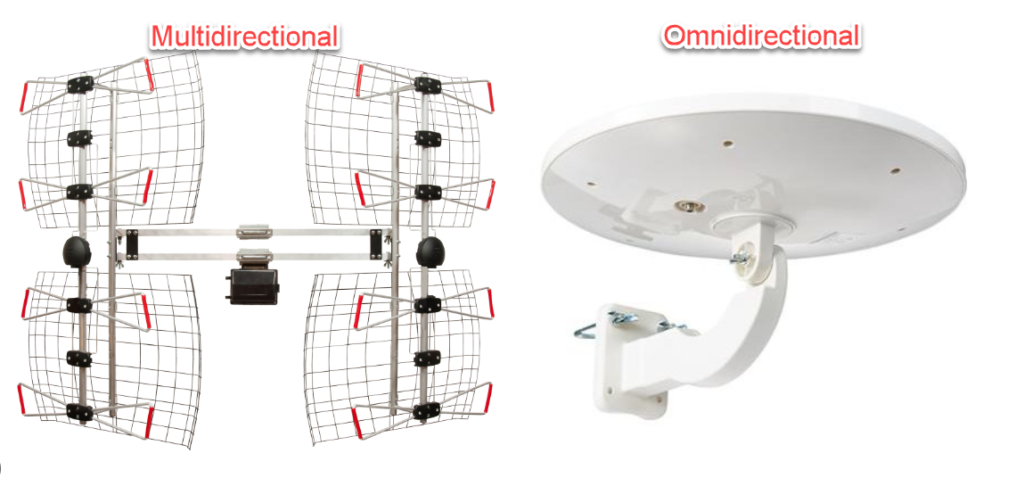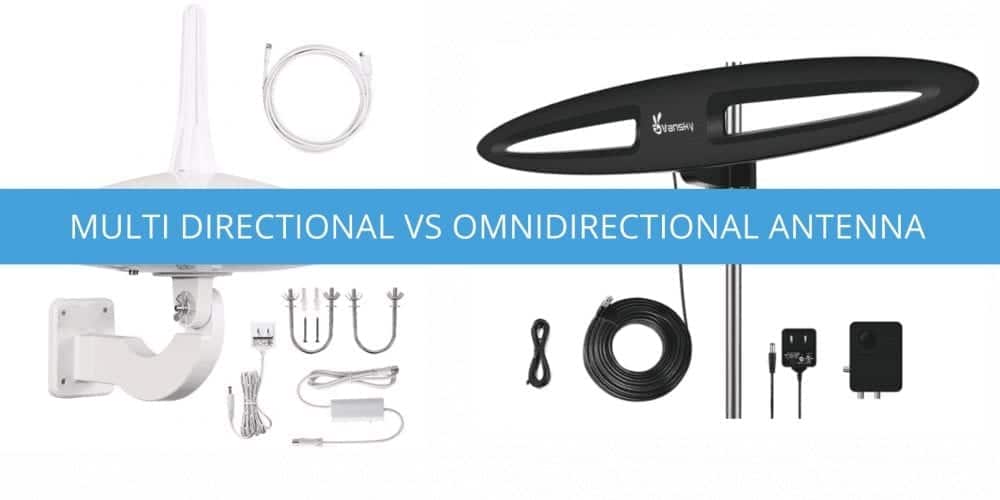Multi-directional and omnidirectional antennas are similar in that they are designed to transmit or receive signals in multiple directions rather than in a single, specific direction. However, there are some differences between the two types of antennas.
Omnidirectional antennas are designed to transmit or receive signals in all directions, 360 degrees around their axis. These antennas are often used in wireless communication systems, such as cell phone towers and wireless routers. They can provide coverage over a wide area without precise aiming. Omnidirectional antennas are also commonly used in portable devices, such as smartphones and laptops, to provide connectivity in various environments and positions.

On the other hand, multi-directional antennas are designed to transmit or receive signals in several directions at once, but not necessarily in all directions. These antennas may have a more focused or directional pattern, allowing them to transmit or receive signals from a specific range of angles. Multi-directional antennas are often used in applications where it is important to have a specific coverage area, such as in point-to-point wireless communication systems or TV antennas.
In summary, both omnidirectional and multi-directional antennas are designed to transmit or receive signals in multiple directions. Still, omnidirectional antennas have a more uniform, 360-degree coverage pattern, while multi-directional antennas have a more focused or directional pattern.
Omnidirectional Antenna
What is an omnidirectional antenna? In this case, omnidirectional antennas are also often called multidirectional antennas. This type of antenna can receive signals from a large number of directions. It is necessary to consider that these units cannot have the ability to focus on a specific transmitter.
Therefore, the signal they can receive has a lower intensity concerning the directional antennas. In combination, this type of antenna is an excellent choice depending on the area in which the person lives. It is advisable to install an antenna with strong signals and TV transmitters not too far away. In this way, it will be much easier to obtain excellent functionality. Here’s an article to check why an omnidirectional TV antenna is better than a normal one.
Pros
Excellent signal reception: As we have mentioned, one of the main benefits that can be obtained in this case is the ability to receive signals from all directions. So an LTE-enabled router can provide efficient routing.
It is an excellent option for several multidirectional cellular mobile base stations. (1)Better performance in case of failure: In this case, it is necessary to mention that the possibility of receiving signals from all directions is another advantage. Here it is possible to receive another signal in case a cellular base station or tower cannot perform well. Even this can happen when the tower is too congested and cannot offer a higher capacity.
Simple installation: This type of antenna has excellent advantages, such as easy use and fast installation. So this can offer an excellent time-saving advantage. However, there are still other advantages to be mentioned.
Quick setup: Additionally, it is also often the case that when the network changes, then an adjustment or realignment may be required. This is especially not the case with the omnidirectional antenna due to its high level of functionality. Network changes could also mean specific problems or new sites and locations.
Cons
Relatively minor overall gain: It is necessary to consider that the maximum performance obtained in an omnidirectional antenna is lower than other options. Thus, since this antenna covers many signals, maximum functionality cannot be achieved in each case.
On the other hand, directional antennas are more functional for maximum performance.
A greater amount of interference: One of the major disadvantages is that an omnidirectional antenna will have to overcome a large amount of interference. In particular, this happens because the signals received come from all directions. Of course, this also decreases the strength of each received signal. Even the ability to receive many signals could quickly become a disadvantage. This depends exactly on the geographical area in which a certain person lives.
Multidirectiona Antenna
Here are some potential pros and cons of using a multi-directional TV antenna:
Pros:
- Focused coverage: Multi-directional TV antennas are designed to transmit or receive signals from a specific range of angles, rather than in all directions. This allows them to have a more focused or directional coverage pattern, which can be beneficial in certain situations.
- Greater signal strength: Because multi-directional TV antennas are designed to receive signals from a specific direction, they may be able to pick up stronger signals from that direction. This can result in better image and sound quality for the received signal.
- Easy to aim: Multi-directional TV antennas are typically easier to aim and adjust than omnidirectional antennas, as they have a more focused coverage pattern. This can make it easier to receive a specific TV station or group of stations.
Cons:
- Limited coverage: One potential drawback of multi-directional TV antennas is that they may have limited coverage compared to omnidirectional antennas. They are only able to receive signals from a specific range of angles, so they may not be able to pick up all available TV stations in an area.
- Vulnerability to interference: Because multi-directional TV antennas are focused on a specific direction, they may be more vulnerable to interference from other sources, such as tall buildings or trees, that may block or weaken the signal.
- Need for precise aiming: To receive a strong signal with a multi-directional TV antenna, it is important to aim the antenna accurately at the desired TV stations. This can require some trial and error, and may not always be possible if the desired stations are located at a wide range of angles.
Ultimately, whether a multi-directional TV antenna is the right choice for you will depend on your specific needs and the TV stations you are trying to receive. It is always a good idea to do some research and consider the pros and cons of different antenna options before making a decision.
Directional Antenna
As we have mentioned, directional antennas are mostly used for specific functionality. In this case, it is an antenna that can be found in many homes. Here, it is possible to have a much stronger signal compared to a multidirectional antenna. Thus, this type of antenna is directed to stations and shelves as television transmitters.
This is why these antennas are used and work much better with weaker signals. To change their orientation or their target, other accessories can be implemented. A good way to complement this functionality is with a rotator. This will make it much easier to change the directionality of the antenna. So a directional antenna is best if you want an excellent experience from a single signal. Even this can be efficient when there are cell phone towers, but they are too far away from your location.
Pros
Increased amplification: The main benefit is that the experience can be optimized by receiving a weak signal. In turn, the directivity gain is much more convenient and allows the user to enjoy more than a multidirectional antenna. Less interference: Here, it is necessary to consider that this type of antenna can be directed toward a certain signal. In this way, it is possible to suppress unwanted signals or interference. Besides, the gain obtained from other secondary signals is significantly reduced.
This interferes/signal ratio is more than balanced and convenient for the user—stability in signal reception: Because the level of interference decreases considerably, the level of stability increases. So, for this to happen, the target base station tower should not be faulty or congested. In case of malfunction, the user should align the antenna to improve the result. In conclusion, it is better to have a directional antenna in more remote locations where there is a very low number of signals.
Cons
Complicated installation: First, it is necessary to consider that this type of antenna cannot be installed anywhere. Instead, finding the most appropriate site is necessary as the antenna will be directed toward a particular target. Otherwise, the result might not be suitable when the antenna is misplaced.
Potential failures: As mentioned, the results can be negative when the cellular base station or tower is faulty and congested. The impact here will be much more severe and considerable compared to an omnidirectional antenna. So to overcome this disadvantage more efficiently, an omnidirectional antenna would be better.
References
(1) LTE – https://www.t-mobile.com/resources/what-is-lte(2) Wi-Fi – https://www.cisco.com/c/en/us/products/wireless/what-is-wifi.html





